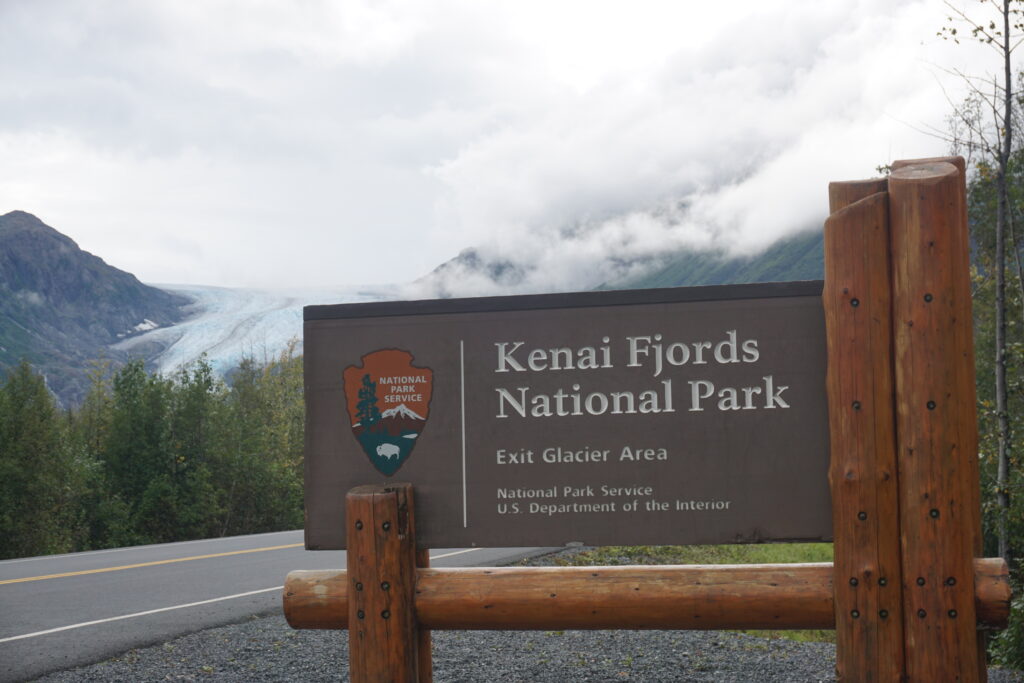The road entrance to Kenai Fjords National Park is marked by a sign, seen on Aug. 27, 2022. The National Park Service has released its annual report on the economic impact of park visitation. Alaska is among the states that reaps the most economic benefit from visitors to its national parks, according to the report. (Photo by Yereth Rosen/Alaska Beacon)
Tourism to national parks in Alaska has rebounded from pre-pandemic levels after three years of lower numbers, according to a report released by the National Park Service.
In all, 3.3 million visitors came to Alaska’s national park sites in 2023, and they spent about $1.5 billion in the local regions, according to the Park Service’s annual visitor spending effects report.
There were 21,300 park-related jobs in Alaska generating $839 million in labor income in 2023, the report said. Alaska’s national park units generated $2.3 billion in economic value to the state, the report said.
The statistics were compiled by the National Park Service, with assistance from the U.S. Geological Survey.
The totals for job numbers, labor income and economic output to the Alaska economy were higher than in 2019, the year prior to the outbreak of the COVID-19 pandemic, according to the report. Total visitor spending in 2023 was about equal to that in 2019, according to the report.
“Solitude, wilderness and deep human connection await in Alaska’s national parks, and I’m proud to see how the parks are benefitting surrounding communities,” Sarah Creachbaum, Alaska regional director for the National Park Service, said in a statement.
Alaska has 23 national park units and is one of the states that reaps the most economic value from its national parks, preserves, monuments and historic sites, according to the report. Alaska ranks fourth among all U.S. states in national park-related visitor spending, jobs, labor income and economic output, according to the report.
The COVID-19 pandemic hit Alaska park visitation particularly hard, however.
Analysis by the Alaska Department of Labor and Workforce Development’s research division found that visitation to Alaska’s eight main national parks fell by 86% from 2019 to 2020, compared to a national decline of 28% for total park visits.
Denali National Park and Preserve, for example, got only 54,850 visits in 2020, less than a tenth of what was recorded in each of the five preceding years, according to the park. Denali is one of the state’s top tourist destinations.
In 2023, visitor totals at Denali were back up to nearly 500,000, according to the Park Service. That was despite a new impediment to travel: the closure at the midpoint of the only road through the park. The 92-mile road has been closed at its midpoint since late summer of 2021 because of an ongoing landslide triggered by thaw. That section of road is expected to remain closed until 2026 as crews build a new bridge at the site.
A different hazard has limited visitation at another popular Alaska national park unit. Severe flooding from storms in the fall of 2022 destroyed bridges and wreaked other damage on the Alaska portion of the 33-mile Chilkoot Trail, part of the Klondike Gold Rush National Historical Park.
The Alaska side of that historic trail has been closed beyond the first four miles, though the Canadian portion of the trail, which lies north of the Chilkoot Pass, remains open.
Indications are that this year’s visitation numbers will be high as well, despite the hindrances at Denali and Klondike Gold Rush. A large percentage of visitors to national parks in Alaska arrive by cruise ship, and cruise passenger numbers this year were expected to break the record set in 2023, according to industry reports.

